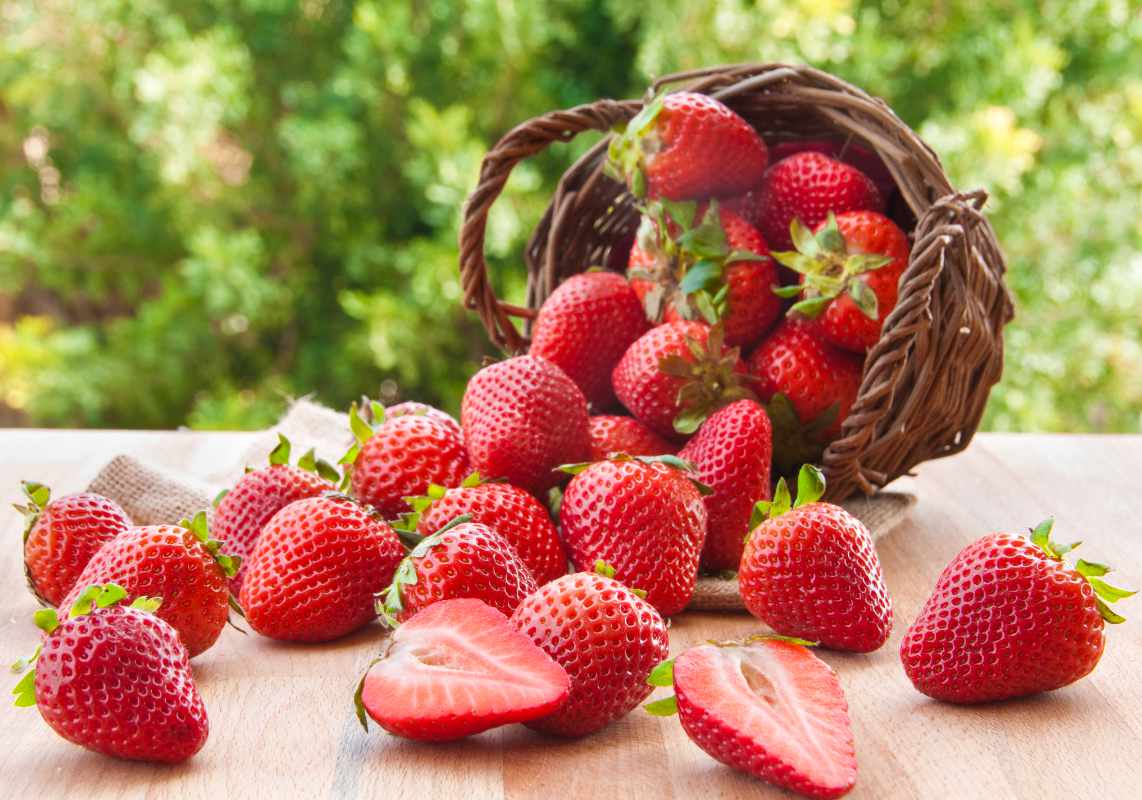Nothing can surpass the sweetness of fresh strawberries, but finding a way to store them and preserve the flavor for extended periods can be daunting.
This article will reveal the best way to store strawberries, keeping them juicy and flavorful for as long as you like.
From storing whole or cut strawberries to ways to preserve them even further - get ready to discover all there is about strawberry storage methods.

⬇️ Table of Contents
📖 How to Store Strawberries
The key to keeping freshly picked strawberries fresh is proper storage.
Here are some essential tips for storing fresh strawberries:
- Leave the stem and leaves on: Keep the leaves and stems intact until you're ready to use the strawberries. This helps prevent spoilage and keeps the berries fresh longer.
- Wait to wash them: Don't wash the strawberries until you're ready to eat or use them. Washing introduces moisture, which can make them spoil faster.
- Generally speaking, plan to use strawberries within 5 to 7 days to keep strawberries fresh and refrigerate them.
- Store your fresh, unwashed strawberries in the refrigerator, either in their original container or in a breathable container lined with a paper towel to absorb excess moisture.
Avoid stacking the berries, which can cause bruising and encourage mold growth. Fresh strawberries should be stored in the refrigerator for five to seven days before strawberries go bad.
🔪 How to Store Cut Strawberries

To keep your cut strawberries fresh and flavorful, place them in an airtight container before storing them in the refrigerator.
This will prevent off-putting odors from seeping into the fruit, allowing you to enjoy its delightful taste for up to three days after cutting!
The Best Methods to Store Strawberries
Keeping strawberries succulent and fresh, even during off-season months, is easy with the many tried-and-true preservation techniques.
1. Storing Strawberries in the Refrigerator
Store your strawberries in an appropriately dry and well-ventilated fridge to ensure they stay fresh and delectable.
Line the bottom of a bowl or glass container with paper towels for an optimal result. Add layer upon layer of berries to the container, then loosely cover it with either plastic wrap or a lid - air needs to be allowed to flow!
And finally, washing strawberries before consuming them; will ensure they stay succulent, as washing before storage can lead to unwanted moisture buildup and accelerate spoilage.
2. Dehydrate

Dehydrating strawberries is an excellent way to preserve their natural flavor while extending their shelf life. Dehydrated strawberries can be stored in an airtight jar and enjoyed as a snack or added to recipes like granola or trail mix.
How To Dehydrate Strawberries
- Wash and prepare the strawberries: Wash strawberries thoroughly to remove any dirt or residue. Remove the stems and leaves, and then slice the strawberries evenly, about ¼-inch thick. Uniform slices will ensure consistent drying.
- Pre-treat the strawberries (optional): To prevent browning and preserve color, you can pre-treat the strawberries by dipping them in a solution of lemon juice and water (1 cup of lemon juice to 1 quart of water) for a few minutes. Drain the strawberries and pat them dry with a paper towel.
- Arrange the strawberries on the dehydrator trays: Place the strawberry slices on the dehydrator trays in a single layer, ensuring they do not overlap. This will allow for proper air circulation and even drying.
- Set the dehydrator temperature and time: Set your dehydrator to a temperature between 125°F and 135°F (52°C to 57°C). The drying time will vary depending on the dehydrator's efficiency, humidity, and the thickness of the strawberry slices. It usually takes 8-12 hours for the strawberries to fully dehydrate.
- Check for doneness: To determine if the strawberries are adequately dehydrated, remove a few slices from the dehydrator and allow them to cool for a few minutes. The strawberries should be leathery and pliable, with no visible moisture when bent or broken.
- Cool and store the dehydrated strawberries: Once the strawberries are dehydrated, remove them from the dehydrator and let them cool completely. Store the cooled, dehydrated strawberries in airtight containers, such as jars or resealable plastic bags, in a cool, dark place. Properly stored dehydrated strawberries can last for up to a year.
Remember that dehydrated strawberries may regain moisture when exposed to humid conditions, so it is essential to keep them in airtight containers and avoid frequent opening and closing.
If you notice any signs of mold or an off smell, discard the affected strawberries immediately.
3. Freeze

Freezing is one of the best ways to preserve strawberries. To freeze strawberries, wash and hull them, then pat them dry with a paper towel.
Arrange the berries in a single layer on a baking sheet and freeze them for about 20 to 30 minutes. Once hard and firm, transfer the frozen strawberries to a freezer-safe, airtight container, and store them in the freezer for up to a year.
4. Make Jam

Transform your fresh berries into jam for a delicious and long-lasting treat. Store the jam in sterilized glass jars and enjoy it for months.
5. Preserves
Preserving strawberries in a vinegar bath is another way to extend their shelf life. Combine one part white vinegar with three parts water and soak the whole strawberries for a few minutes. Drain and dry the berries thoroughly before storing them in a glass jar in the refrigerator.
🍓 How to Preserve Strawberries
In addition to the methods mentioned above, here are some creative ways to preserve strawberries:
6. Strawberry Fruit Leather

Transform your traditional berries into a delicious and convenient snack with the simple process of making fruit leather.
Start by blending them to create a puree, then spread it across a greased baking sheet before dehydrating them in either an oven or food dehydrator.
Cut the dried mixture into strips once ready, and store them in an air-tight container for future snacking.
7. Strawberry Wine

If you're feeling adventurous, try making strawberry wine. This process involves fermenting the berries, which preserves their flavor and allows you to enjoy them in a unique way.
In Summary
Storing fresh strawberries properly can make all the difference in preserving their freshness and flavor.
Using the methods outlined in this article, you can enjoy your strawberries longer, reduce waste, and even find creative ways to enjoy these delicious berries out of season.
Whether keeping them in the refrigerator, freezing them, or preserving them in various forms, there's a perfect method for every berry lover.





Leave a Reply